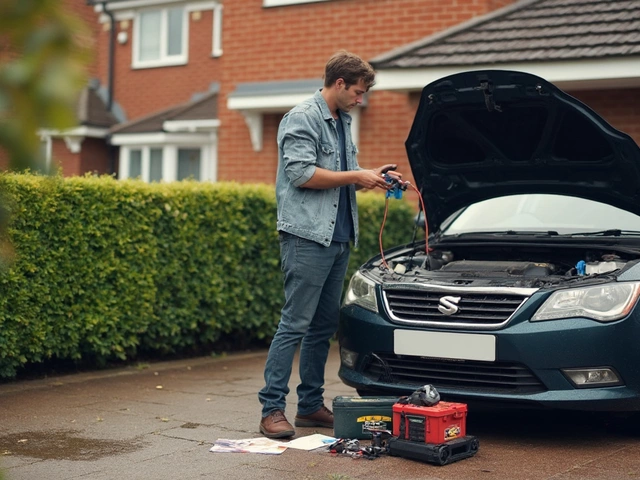Car suspension systems are an integral part of your vehicle's overall performance and comfort. They are designed to absorb shocks and maintain tire contact with the road, ensuring a smooth driving experience. But what happens when your suspension feels too stiff? Is it just a preference issue or a sign of a larger problem? Understanding the balance between stiffness and comfort is key.
Drivers can usually feel the difference when a car's suspension is too stiff. This can translate to a rough ride, causing discomfort on longer journeys. Moreover, it may also affect your vehicle's handling, potentially making it unsafe. A stiff suspension might be great for sports cars on the track, but not necessarily for daily driving.
Identifying the signs of stiff suspension and understanding how to address them can help maintain your car's performance and your comfort. From uneven tire wear to a bumpy ride over what should be smooth roads, knowing what to look for can prevent problems before they escalate. With a few adjustments, you can enhance your driving experience, making those commutes or road trips more enjoyable.
- Understanding Suspension Basics
- Signs Your Suspension Might Be Too Stiff
- Effects of Stiff Suspension on Driving
- How to Test and Diagnose Stiffness
- Tips for Adjusting Suspension Settings
Understanding Suspension Basics
Getting to grips with your car's suspension system is essential not only for improving your ride quality but also for maintaining your vehicle's safety and performance. At the heart of any car's suspension system are its springs, shock absorbers, and linkages, which work in tandem to ensure that each wheel remains firmly planted on the road. This system helps in managing the relationship between the car's body and its wheels, absorbing shocks from uneven surfaces and allowing the suspension to adapt to various driving conditions.
The car suspension can be remarkably complex, with different components designed to perform specific functions. The springs bear the vehicle's weight and absorb road shocks, while shock absorbers dampen the movements caused by these shocks, preventing the car from bouncing. Additionally, a set of linkages ensures that the wheels maintain optimal alignment with the frame or chassis, which is critical for ensuring stable and safe steering. Understanding these elements individually can highlight why a vehicle might have a stiff suspension and how each piece plays a role in that experience.
Car manufacturers often fine-tune suspension stiffness to meet the specific needs of different vehicle types. For instance, sporty models may boast firmer suspensions to enhance performance on curves and during high-speed maneuvers, emphasizing precision and control over comfort. In comparison, luxury sedans and SUVs tend to focus on softer suspensions to deliver a plush ride, prioritizing comfort and smoothness. Knowing where your vehicle fits along this spectrum can shed light on what you may perceive as a stiff or soft ride and if adjustments are needed to align with your driving preferences.
Historically, advancements in suspension technology have significantly impacted how we drive. Early vehicles relied on rudimentary systems that offered little in the way of comfort. But today, sophisticated systems can adapt to road conditions instantaneously. As automotive engineering continues to evolve, we see the integration of technologies like magnetic ride control and adaptive air suspension, which actively modify the suspension settings for an optimal driving experience. These innovations are particularly prominent in high-end vehicles, where the emphasis is on blending performance with unmatched comfort.
For those interested in the technical side, data from various studies can often illustrate how suspension tuning affects vehicle dynamics. A study by the National Highway Traffic Safety Administration noted that vehicles with optimally tuned suspensions experienced fewer yawing motions during rapid steering maneuvers, which contributed significantly to the overall safety ratings of those vehicles. Such details offer a glimpse into how precision engineering in suspension systems can enhance safety while still delivering a comfortable ride.
"A car's handling characteristics and comfort levels are largely dictated by the suspension system," says Dr. Leslie Canter, a leading automotive engineer. "It's the marriage of artistry and science, where every component from struts to bushings plays a role in defining the vehicle's personality on the road."
Signs Your Suspension Might Be Too Stiff
Driving with a stiff suspension feels like you're on a bumpy roller coaster ride. One of the common telltale signs is feeling every single nook and cranny on the road. If you find yourself cringing over potholes that once felt like a small bump, your suspension might be too rigid. The car seems to be communicating through juries and jolts rather than just easing over the road. This is especially common in vehicles that have been modified for performance but can occur in standard setups too. The dilemma with car suspension is balancing comfort and handling, and when stiffness increases beyond a certain point, comfort significantly decreases.
Another clear indicator is the audible and physical feedback you get from within the vehicle. A stiff suspension tends to produce more noise because the reduction in damping means less absorption of sound and jolt. This means passengers might hear all sorts of rattles and shakes, sometimes even from areas you didn't expect. The vehicle's dashboard and other interior components might start producing noises that weren’t there before. This soundscape can transform what should be a peaceful drive into a clattering cacophony.
It's not just about sound either. Your tires can tell you a lot about your suspension status. With suspension stiffness, the vehicle might exhibit abnormal tire wear patterns. This happens because the tires can't maintain even contact with the road. You may notice wear on the inside or outside edges of the tires more than usual. Keeping an eye on your tires and knowing that their health reflects the suspension condition is crucial. A tire inspection might reveal unusual patterns that point to excessive stiffness in the suspension system.
Moreover, handling quirks can signal that your suspension setup is not ideal. For instance, a stiff car suspension might make cornering uncomfortable as the vehicle doesn't absorb the sideways load efficiently. The car could feel skittish or resistant while trying to maneuver smoothly through turns. This can be worrying not just for comfort but also for safety. As the suspension fails to cushion the forces, the car might understeer or oversteer too much. This means drivers have to be really alert and adjust their handling to compensate for these challenges.
“A suspension that's too stiff can change the whole character of the car. Finding the right balance is key for both performance and comfort,” says James Barker, a renowned automotive columnist.
Lastly, feeling fatigued after a drive can be telling as well. When vibrations and jolts reach the occupants directly due to a lack of damping, the journey becomes taxing. A drive that should feel seamless instead seems like an endurance test. If trips that used to be relaxing leave you feeling worn out, your suspension system might be contributing more to driver fatigue than you think. These signs can guide you towards identifying and remedying suspension issues before they translate into bigger problems.

Effects of Stiff Suspension on Driving
When we talk about the effects of a stiff suspension on driving, we are delving into an interesting territory where comfort meets control. A suspension system’s main job is to ensure your car’s wheels remain in contact with the road, which is fundamentally about balance. If the suspension is too stiff, the ride quality can be compromised. Imagine driving over a series of small bumps; with a stiff setup, each bump is felt sharply through the cabin, translating to discomfort over time. This harshness isn't just a matter of luxury; it can lead to real fatigue on long journeys.
Moreover, it's not just your back that might complain. Stiff suspensions can also lead to erratic handling behaviors. On smooth surfaces, you might have precision that feels like a dream, but hit an uneven patch, and the car can lose grip unexpectedly. The stiffer suspension reduces the time your tires have to adjust to changes in the road surface, affecting your car's handling dynamics in critical moments. Drivers often describe an unsettling feeling, describing it as the car being "skittish." This happens because the tires don't have the flexibility in their contact patch on rough terrains.
It's worth noting how speed plays into this equation. At high speeds, the choice of suspension can be the line between smooth cornering and feeling like you're on a roller coaster. The harder the ride, the less forgiving the suspension. Stiff setups are often appreciated on race tracks, where roads are perfectly smooth, and precision is paramount. However, on city streets riddled with potholes, this stiffness can cause not only discomfort but potential damage as well. Fast cornering becomes a chore, with the car leaning less into corners, which may sound wonderful, but comes at the cost of absorbing less of the road's nuances.
Experts often say that a car suspension needs to fit the environment it drives in swiftly. An insightful point from engineering specialist John Smith states,
"A suspension stiff enough for track performance mustn't be confused with the needs of everyday roads; adaptability is integral to long-term comfort and vehicle integrity."This means that while it's tempting to have a suspension that gives you track-like performance, real-world driving often requires a more forgiving setup. A stiff suspension can also lead to increased wear on various components. Wheels bear the brunt of every bump, causing higher maintenance requirements for hubs, amplifiers, and even tires.
Drivers should be aware of the trade-offs involved with a super stiff suspension system. The added vibrations translate to more stress on the car body itself, manifesting over time in issues with fittings, a car’s structural stress points, or even bulkier rattles. And there's the monetary aspect – all that shakes constantly leads to more frequent check-ups and component replacements. It's a question of whether the thrill of a race-car feel is worth the extra bills in maintenance. By understanding these nuances, one can make informed choices about how they prefer their cars to perform day-in, day-out, balancing between spirited driving and everyday practicality.
How to Test and Diagnose Stiffness
Determining whether a car's suspension is too stiff involves a blend of observational skills and practical testing. Begin by paying attention during your regular drives. Are you feeling every little bump and crack on the road? Such jolts can indicate that your vehicle comfort might be compromised due to stiff suspension. Riding on a known smooth surface, such as a new tarmac, can help you identify anomalies in the ride. Remember, the suspension should create a balance between comfort and control, and anything that feels jarring might warrant a closer inspection. A simple test involves pushing down on your car's hood or trunk. If your vehicle bounces back hard and settles quickly, it suggests a stiff suspension setup. Ideally, the car should bounce once and return smoothly to its default position.
For a more diagnostic approach, consider performing a bounce test. This involves examining how the suspension reacts to pressure. With the car parked on a level surface, press down firmly on a corner of the car. A vehicle with appropriately tuned suspension will bounce back up once and settle into its original position without extra oscillations. Repeat this test on all four corners to check uniformity. Consistency is key here, as variations might indicate uneven suspension stiffness or problems with specific components. Professional mechanics often use specialized equipment to gather more precise data, but these simple steps can help you notice issues with a layperson's understanding.
Another practical tactic is examining tire wear. Surprisingly, your tires can tell you quite a story about your car's suspension. If only the middle of the tread is wearing down rapidly, it might indicate a stiffness issue in the suspension. This happens because the tire remains in less contact with the road, bouncing more rather than staying grounded through flexible movements. Regularly scheduled alignments can mitigate this, so check if yours are overdue. Uneven wear patterns or consistent wear can all provide clues that something may be off. Also, pay attention to any noise coming from the suspension system. A clunking noise over bumps could be a sign that parts of your suspension, like shocks or struts, may be worn or not performing correctly.
It's wise to correlate your findings with the automobile's specifications. Consult the owner's manual or manufacturer's guidelines to understand the intended ride comfort. Sports cars, for instance, have inherently stiffer suspensions compared to family cars, which prioritize comfort over sporty performance. If your vehicle doesn't perform as expected based on these specs, it's time to call in the experts. Bringing your car to a professional can also confirm any suspicions, utilizing their experienced eye and tech tools to verify stiffness concerns. Diagnosing your car with these preliminary checks can prevent more significant issues from developing over time and help prolong the life of both your car's suspension system and the tires.
"A good suspension setup can absorb irregularities yet provide ample feedback," says automotive expert, John Lenoir. "Finding the right suspension balance not only enhances ride quality but also boosts driver confidence."
Finally, technology today provides advanced aids in this process as well. Some modern cars come equipped with diagnostic systems that alert you to suspension problems through dashboard warning lights or message alerts. While these should not be solely relied upon, they can offer an added layer of reassurance. For those preferring a hands-on approach, there are aftermarket diag tools available that plug into your car's computer system to offer a detailed analysis of its performance. Combining these technological insights with traditional testing methods can be a great way to confirm your suspension status.

Tips for Adjusting Suspension Settings
Adjusting the suspension stiffness on your vehicle is an art, blending mechanical adjustments with personal preference to achieve the ideal driving experience. Whether you're noticing an uncomfortably bumpy ride or just curious about optimizing your car's performance, there’s a host of strategies that can help you tweak your vehicle’s setup. First off, it’s important to understand the components of your suspension system — shocks and struts play a crucial role, and knowing what each does can guide your adjustments. For those serious about performance, investing in adjustable coilover suspension systems might be a great step. These systems offer the ability to change the vehicle's height and dampening rates, providing flexibility to fine-tune your ride quality. If your car feels too rigid, you might need to adjust these settings or even replace certain components with more suitable aftermarket parts.
Exploring the intricacies of tire pressure and its impact on ride quality is another aspect worth considering. Often overlooked, tire pressure can dramatically influence how your vehicle feels on the road. Uneven or excessively high tire pressure may exacerbate an already stiff suspension, leading to unnecessary discomfort. It's advisable to regularly check and maintain the recommended pressure levels stated by the manufacturer, not just for comfort but also for safety.
"A well-balanced suspension not only improves comfort but also maximizes your car's handling potential," says Tom Burkart, founder of CarRevsDaily.com.Tuning your tire pressure can sometimes be a quick fix to achieve a softer ride without delving too deep into technical adjustments.
Sometimes, working with your car's OEM components like bushings and sway bars might be sufficient. Adjusting or upgrading these components doesn't just affect the stiffness but can also change the handling characteristics of the vehicle. Stiffer bushings and sway bars increase your car's resistance to body roll but might contribute to a stiffer ride. Replacing them with softer ones could help alleviate some of the harshness. For those looking further into suspension geometry, tweaking the alignment and camber settings might also offer some relief, providing a broader range of handling and comfort outcomes. It’s also beneficial to maintain and inspect the condition of the existing suspension parts. Even something as straightforward as replacing dampers or springs due to wear and tear can significantly alter the ride quality, restoring a balance between handling and comfort.
Technology has seeped into suspension systems in interesting ways, with electronic adjustments becoming more common in modern vehicles. For the tech-savvy driver, this opens a plethora of options with just a few taps or dial turns. Vehicles equipped with electronically adjustable shocks or struts allow real-time changes to comfort settings, often offering pre-set modes ranging from 'garage' to 'track'. Keeping up with the latest advancements can sometimes offer a much simpler solution to a complex suspension dilemma. A glance at vehicle forums or discussing with fellow enthusiasts frequently brings out informative insights on setting options that could align with new innovations.
When modifying car suspension, always consider the environment in which you most frequently drive. City driving with its endless potholes and sharp speed bumps, compared to highway cruising, requires different suspension setups. It's not unusual for a suspension that's perfect for the racetrack to fall short on the commute to work. Understanding your primary driving scenario aids significantly in making the right adjustments. Ultimately, finding that sweet spot isn't just about comfort; it's about safety, longevity of vehicle components, and in many cases, simply enjoying the ride.





